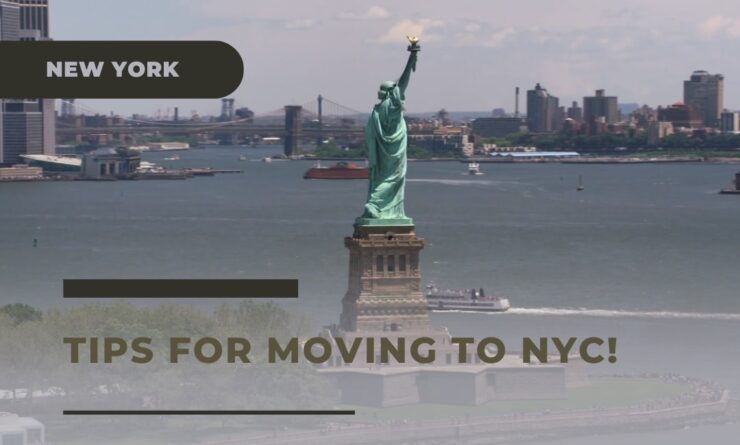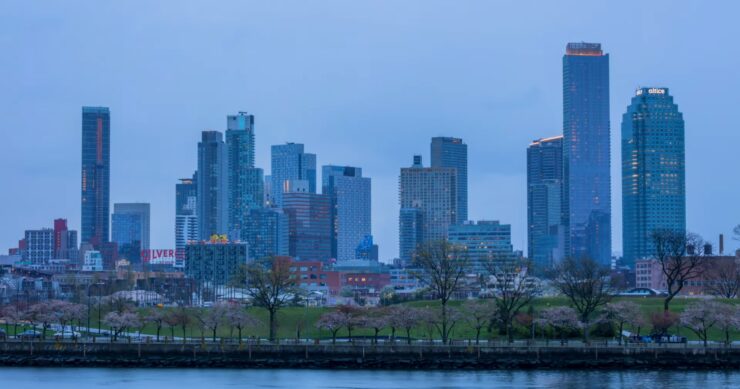Are you flirting with the idea of becoming a New Yorker? Well, you’re in luck!
Two years ago, I took the plunge and embraced the city that never sleeps. Now, I’m here to pass on my wisdom and make your transition to the Big Apple as smooth as a jazz tune in a Harlem club. But, as with any major decision, there are pros and cons to consider.
Forget the chit-chat and family recipes, we’re here for the real deal. So, buckle up and get ready for a whirlwind tour of everything you need to know about making New York City your new home. Let’s dive right in, shall we?
Overview
This comprehensive guide provides an in-depth look into the realities of moving to New York City (NYC). It covers a range of topics, from the financial preparations needed, such as saving up to $20,000 and securing a job before moving, to the intricacies of the NYC real estate market, including the infamous broker fees and the intense competition for apartments.
We’ll also discusses the high cost of living in NYC, which is the 6th most expensive city worldwide, and the need to embrace small living spaces due to the premium on space in the city. It highlights the benefits of living in NYC, such as access to world-class museums and a vibrant 24/7 food scene, and the convenience of the city’s public transportation system, which makes owning a car unnecessary.
The Big Question: How Much Should I Stash Away Before Making the Big Move to NYC?
My sister, currently on her own journey to become a New Yorker, popped this question to me half a year ago. The answer, my friend, is as diverse as the city’s skyline, depending on your lifestyle. But, as a rule of thumb, I’d recommend having a cool $20,000 in your pocket before you pack your bags for the city of dreams.
Securing an apartment in NYC is like buying a golden ticket to Willy Wonka’s factory – it’s not cheap, and it’s quite a ride! Most landlords will ask for the first and last month’s rent, plus a security deposit (equivalent to a month’s rent) upfront. This is one of the cons of moving to NYC – the high cost of living.
The average rent for a one-bedroom apartment in my neighborhood is a whopping $3,000 per month (I can hear my wallet crying as I write this). So, I had to part with a hefty $9,000 just to get my foot in the door (including a non-negotiable broker fee of $3,000).
Broker fee? Oh, you bet! That’s one sneaky little monster we’ll be tackling below. As promised, we’re about to dive deep into the nitty-gritty of moving to New York City. So, keep reading!
Moving to New York City
Location, Location, Location
No kidding, right? I guess that’s the biggest open secret ever, huh?
Before the skeptics start rolling their eyes, let me assure you that I’ve always appreciated the significance of picking the right neighborhood when moving to a new city. However, my understanding went to a whole new level when my hubby and I began hunting for apartments across the boroughs of the Big Apple. This is one of the pros of moving to NYC – the variety of neighborhoods to choose from, each with its own unique charm.
The budget you’ve set aside could land you a whole variety of homes depending on which neighborhood you fancy. It was like a reality check on steroids for us. For instance, your $3,000 might get you a comfy one-bedroom pad in the Upper West Side but could also mean a dicey dwelling (to put it mildly) in SoHo.
We once checked out an apartment in SoHo, which was more of a glorified cupboard than anything. We beat a hasty retreat – the light was practically absent, the bathroom wall was in shambles, revealing an ominous dusty pipe. The grand finale was a deceased cockroach in the kitchen, seemingly sending us a sassy message from beyond, “Honey, aim for the north.”
So, let’s get to the point: research is your best friend before moving to New York City. What are your priorities in terms of accessibility? What amenities are non-negotiable for you? And, most importantly, what are you willing to compromise for the perfect location?
The Art of Handling Broker Fees
Brokers and their fees are the heart and soul of the NYC real estate scene. Newcomers to the city often find this hard to swallow, so let’s break it down:
Broker fees are an infamous New York practice where securing an apartment comes with the added expense of paying the broker. Generally, this amounts to either one month’s rent or 15% of the annual net rent. In our case, with the apartment costing $3,000, we were shelling out a broker’s fee of $3,000.
This mandatory charge comes on top of the security deposit and the rent for one/two months. The peculiar part about the broker fee is that you still need to do the heavy lifting in terms of hunting for an apartment. The broker merely opens the door for you. But, oh well, they get to pocket a tidy sum equal to a month’s rent since they’re the gatekeepers to your dream apartment.
This is a classic NYC lesson – embracing the unconventional. That’s how the Big Apple rolls, and it doesn’t change for anyone. You just need to tune your expectations (and sign those hefty checks).
Broker fees are under legal scrutiny, but until any concrete resolution comes to light, you’ve got to factor them in when planning a move to NYC.
The Bear of an Apartment Search in New York City
Apartment hunting in any city can be nerve-wracking, but NYC just has to outdo them all. I’ve resided in a couple of cities before relocating to NYC and searching for an apartment here was hands down the most taxing. The competition is fierce and prices are astronomical. This is another con of moving to NYC – the intense competition for housing.
StreetEasy is your best bet for finding an apartment in New York City. It has a vast array of options and is super user-friendly. A word of caution though — apartment hunting can be oddly addictive! We found ourselves glued to the screen, constantly refreshing the page for a whole month.
Here’s a tip we picked up during our search:
A smart move my partner and I made was to get hold of an application form from the broker before touring the apartment. We filled up the application and sent it back to the broker before seeing the apartment (we didn’t pay the fee, so it remained “incomplete”), giving us a head start in the application process.
When we finally came across the apartment we adored, we just needed to sign the application and pay the application fee (usually about $25). Having the application form filled in advance made us the first to submit the necessary paperwork, ensuring we got first preference for the apartment.
The downside is the amount of personal information you’d have to share with numerous brokers. We had to send across our bank statements, W2, and so on every time we applied. It was a leap of faith but turned out just fine for us, even after nine applications.
It’s Essential to Visit the Apartment In Person
Trust me on this, folks. I’ve lost count of the number of times I’ve visited an apartment, only to be left wondering if I’d walked into the wrong one.
For instance, the kitchen cabinets were blue, even though I could swear they were white in the pictures. When I queried the realtor about the discrepancy, she admitted that brokers sometimes resort to stock images while posting rental apartments. So, the takeaway here is — NEVER sign a lease without seeing the apartment in person unless you have a penchant for unpleasant surprises.
Consider this — we visited more than nine apartments and would have been massively let down if we’d gone by the photos alone. Plus, touring the apartment gives you a sense of the overall vibe of the building.
We once checked out an apartment which was quite decent, but the sight of mouse traps in the hallway was a deal-breaker.
Be Prepared for an Overload of Application Paperwork
The application process is not just incredibly intrusive, but it also differs from one realtor to another. Some demand two years of tax records, three pay stubs, a letter of employment, a reference from your previous landlord, a snapshot of your bank balances, and even certified letters from a CPA. The only thing they stop short of asking for is a DNA sample from your firstborn.
Why this paperwork frenzy? Most landlords in New York mandate that your yearly income be 40 times the monthly rent. Here’s the math — multiply your monthly rent by 40. So, if you’re going for an apartment that costs $3,000 per month, you need to be making $120,000 annually ($3,000 x 40).
Summer Relocation to NYC? Nope
As if the NYC rental market isn’t expensive enough, it turns out that summer makes it even worse due to a spike in people moving during these months. This makes perfect sense – think college students relocating to the city, fresh grads beginning their professional journey post-graduation, and so on.
Summer is undeniably the most competitive period to find an apartment in New York City. With the inventory being low, prices inevitably go through the roof. Try your best to avoid the June – September period for your move to New York City. This will enhance your chances of landing a good apartment, sans the exorbitant summer prices.
New York City Might Just Make Your Wallet Weep
Sure, you’re aware that New York City is pricey, but did you know it’s the 6th most expensive city worldwide?
This bit of trivia is my way of emphasizing the need to either have a hefty bank balance or a bulletproof strategy. If you don’t have either, better invest in a decent phone plan, because mom is going to get a whole lot of calls.
Everything, from groceries and entertainment to rent, is going to set you back considerably more when living in New York City. At times, it seems as though simply waking up in NYC might set you back $400!
Which brings us to the next crucial aspect of moving to New York City — securing a job.
Land a Job Before Your Big Move
Every year, thousands of bright-eyed, ambitious folks move to New York City, dreams sparkling in their eyes and resumes in their hands. And why not? The city offers innumerable opportunities and the chance to be part of the iconic NYC hustle. But here’s my advice: don’t join the party unless you’ve got a job offer in hand or substantial savings to fall back on.
The city is unbelievably expensive, and while the salaries are higher compared to the national average, they aren’t always sufficient to maintain a comfortable lifestyle. It’s crucial to have a stable income before you make the move.
If you’re transitioning between jobs, ensure that you have a financial safety net that can sustain you in New York for at least 3-6 months. Trust me, you wouldn’t want to face the brunt of the Big Apple’s high living costs without a steady income.
Embrace the Small Spaces
Space is a luxury in New York City. If you’re moving from a suburban area or a smaller city, the apartment sizes in NYC might come as a shock. That sprawling two-bedroom apartment in Houston for $1,500? It could easily shrink to a 400 sq ft studio in Manhattan for the same price!
New Yorkers have perfected the art of utilizing small spaces. It’s not uncommon to see apartments with loft beds, compact kitchens, and multipurpose furniture that transform and fold away when not in use. It’s all about making the most of what you have.
So, if you’re not ready to compromise on space, New York City might be a tough sell. On the flip side, the small spaces could offer a chance to declutter your life, streamline your belongings, and embrace minimalism.
Unlock a Treasure Trove of World-Class Museums
Ever thought of living in a city that’s a hotbed of cultural treasures, right on your doorstep? Welcome to New York City – home to an astonishing collection of 83 museums, including the mighty Metropolitan Museum of Art, fondly referred to as ‘The Met.’ The fifth largest museum on planet earth, right in your backyard!
Imagine starting off every weekend diving into the mesmerizing world of art with your little ones, letting their minds wander through ancient relics, modern masterpieces, and everything in between. By the age of seven, they would have savored more fine art than most people do in a lifetime! That’s New York City for you.
Satiate Your 24/7 Food Cravings
The city that never sleeps also never stops serving mouth-watering food. NYC is a culinary wonderland, a smorgasbord of diverse cultures simmering together in one giant melting pot. All this fusion and more promises gastronomic delights for all, around the clock.
Experienced the sheer joy of cradling a hot bowl of award-winning ramen at 1am yet? If not, NYC will change that. And be warned, once you’ve tasted this, life will never be the same.
Say Adios to Cars in NYC
Moving to New York City gives you the golden chance to ditch the car and embrace the world on foot, or by subway. Bid farewell to the constant expenses of gas, maintenance, insurance, and parking, and welcome the convenience and efficiency of NYC’s public transportation.
In a city where the only thing affordable might be the subway, each ride costs just $2.75. And if you’re a regular commuter, the 7-day pass at $33 or a monthly pass at $127 is a steal. What’s even better? Some employers offer free subway passes!
So, if you’re planning to move to NYC, keep your car behind. With dense traffic and scarce, expensive parking, a car is more a bane than a boon here. Let the subway be your new ride. Besides, wouldn’t you rather be exploring the city than worrying about moving your car each week to avoid parking tickets?
FAQ
is it true that I need to earn 40 times my monthly rent?
Yes, it’s true! Most landlords in NYC require that your yearly income be 40 times the monthly rent. So, if you’re eyeing an apartment that costs $3,000 per month, you need to be making $120,000 annually. So, before you fall in love with that swanky apartment in Manhattan, do the math!
Should I ditch my car when I move to NYC?
Absolutely! In NYC, the subway is your new ride. With dense traffic and scarce, expensive parking, a car is more of a headache than a convenience here. Plus, the subway ride costs just $2.75. So, say adios to your car and embrace the world on foot or by subway.
Is it true that NYC is the 6th most expensive city worldwide?
Yes, it’s true, NYC is one of the most expensive cities you can live in the US! Living in NYC can make your wallet weep. Everything, from groceries and entertainment to rent, is going to cost you more. So, unless you have a hefty bank balance or a bulletproof strategy, be prepared for some sticker shock!
Can I really get ramen at 1 am in NYC?
Absolutely! The city that never sleeps also never stops serving mouth-watering food. Whether it’s award-winning ramen at 1 am or a hot dog from a street vendor at dawn, NYC has got you covered. So, get ready to satiate your 24/7 food cravings!
How can I survive the summer relocation rush in NYC?
Surviving the summer relocation rush in NYC is all about timing. Try to avoid moving between June and September when the rental market is at its peak. If you can, plan your move for the off-peak season to avoid the exorbitant summer prices.
Do I really need to visit the apartment in person before signing the lease?
Yes, you do! Pictures can be deceiving, and you don’t want any unpleasant surprises when you move in. Plus, visiting the apartment gives you a sense of the overall vibe of the building. So, always make sure to see the apartment in person before signing on the dotted line.
Final Words
Moving to New York City is a big decision, but with the right planning and a sense of adventure, it can be the start of an exciting new chapter in your life. The city is full of opportunities, cultural experiences, and culinary delights that are sure to keep you entertained and inspired.
Remember, the key to a successful move is preparation. Do your research, plan your budget, and be ready to embrace the unique lifestyle that NYC offers. It might be a bit overwhelming at first, but once you get the hang of it, you’ll find that there’s no other city quite like it.
So, are you ready to take the plunge and become a New Yorker? The city that never sleeps is waiting for you. Welcome to the Big Apple!























